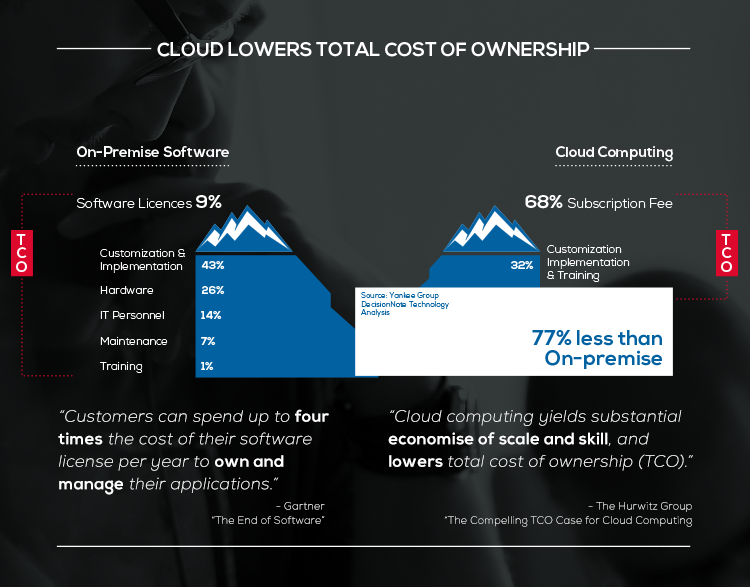 How many asset managers have made a serious study of the total cost of ownership (TCO) of their on-premise performance measurement system?
How many asset managers have made a serious study of the total cost of ownership (TCO) of their on-premise performance measurement system?
The results of such an analysis are likely to come as a shock, particularly when compared to cloud-based solutions offer software-as-a-service and platform-as-a-service products.
It is now almost 30 years since the IT market research specialist Gartner set out the basics of TCO analysis. The principle is that the cost of a particular IT solution includes not only the upfront price of acquiring it but a host of other considerations that may be hidden. The TCO might, for example, span hardware and software acquisition, management and support, communications, end-user expenses and the opportunity cost of downtime, training and other productivity losses.
{{cta(‘bcdd0f82-15ab-4a31-97d7-953aaeb085d7’)}}
Only by comparing all such costs is it possible to assess whether the solution in question provides better value than an alternative.
In the case of asset managers’ performance management systems, the hidden costs of an on-premise solution are likely to be substantial, particularly when weighed against cloud-based alternatives.
Consider the following:
Hardware costs
These are likely to be high for an on-premise solution, with in-house IT staff required to ensure servers have the capacity to run the system. The asset manager will also incur the considerable costs of a data center capable of dealing with the large – and increasing – volumes of data passing through their business. The system may also have to be installed across several environments , spanning production, development, disaster recovery and end user testing.
By contrast, cloud-based solutions will be substantially cheaper on these metrics, since they shouldn’t require the asset manager to install any hardware at all.
User licensing fees
This is at least a more visible cost when budgeting for an on-premise performance measurement system, but will be substantial. Moreover, the upfront cost will limit the system to a maximum number of users – adding additional users as the business grows will incur further charges. In a cloud-based system, meanwhile, licensing fees, or similar, will also loom large in the total cost analysis, but vendors operate a range of different fee structures, and systems are scalable up and downwards.
Implementation and training
Even with the assistance of the product vendor, installing an on-premise performance measurement system, and ensuring staff understand how to work with it, is likely to be time-consuming and expensive, diverting IT resources from the rest of the asset management’s business. In addition, these costs will be incurred all over again when the system is upgraded or replaced. A cloud-based implementation, on the other hand, largely happens off site – and while there will be training requirements, these should be included in the cost of the solution, with ongoing service and support also provided.
Maintenance and upgrade work
Once an on-premises system is in place, in-house IT staff will largely be required to maintain it on an ongoing basis. Those staff will also be required when the system is upgraded, though some support may also be available from the vendor. Upgrades, in any case, may only be available at additional cost. After a period of time, moreover, the asset manager may decide it needs to replace the system, starting the cycle all over again.
By contrast, cloud-based solutions do not generally pose any of these headaches – one of the crucial selling points of this approach is that maintenance, upgrades and enhancements are provided automatically and remotely, and managed by the system provider. Upgrades are more frequent, but smaller in nature meaning fewer functions to test and sign-off. A much more efficient process than an annual ‘big bang’ of software upgrades for on-premise systems.
In-house IT resources.
An on-premise solution will require the asset manager to retain IT staff with specialist experience of the system, diverting resources that could be put to more productive use on core areas of the business. The opportunity cost is potentially very significant. A cloud-based system, by contrast, should consume minimal in-house resources as there are no software installations to manage or support.
In other words, asset managers that take the time to quantify the full cost of their on-premise performance management systems are likely to find that while the headline figure may be broadly comparable to the upfront bill for a cloud-based solution – albeit structured much less flexibly – the ongoing costs are likely to be substantially higher.
Moreover, these are the most obvious and direct costs of an on-premise solution, but there will be many others. For example, few asset managers will have considered the energy costs associated with the servers and data centre infrastructure required for an on-premise system, though research suggests these may be very substantial. It’s also difficult to assess the value of opportunities that the business misses out on because resources are sucked into operating and maintaining an on-premise system. This may be sizeable, given the increasing value of IT across so many core functions of asset management.
On the flip-side, cloud does present challenges that will need to be weighed. Some analysts point to the cost of migrating to a cloud arrangement. Data privacy and security will be a key issue to address. And asset managers will need sufficient bandwidth available to use a cloud-based solution effectively.
The data sovereignty and security questions will always be there with cloud-based platforms, but there are many solutions to these challenges with various hosting locations and encryption methods available. This includes secure encryption key management giving the asset manager control over encrypted data to ensure privacy and compliance with regulators. The irony is that many on-premise systems have far less robust security controls in place simply because they are behind the corporate firewall.
Nevertheless, asset managers that make a comprehensive study of on-premises performance management systems versus cloud-based solutions will almost certainly come down on the side of the latter, at least in cost terms. Such an analysis has the potential to secure real value over the medium to long term.
Takeaways
- The hidden costs of on-premises performance management systems may be substantial
- Cloud-based performance management systems offer potential savings, particularly on an ongoing basis
- Asset managers weighing the choice between on-premises and cloud should consider the opportunity cost of deploying scarce resources to the former
- Cloud solutions can present data sovereignty and security challenges, make sure your cloud vendor is an expert on these
- Cloud-based platforms have many more security features ‘baked in’ versus legacy on-premise systems
- Not all areas of the asset management IT estate are ready for the cloud, but middle office processing such as performance measurement is well suited
Find new ways to make the complex simple
{{cta(‘fa3b4f0d-4c30-4f05-8a1f-f9f2febb3edb’)}}
